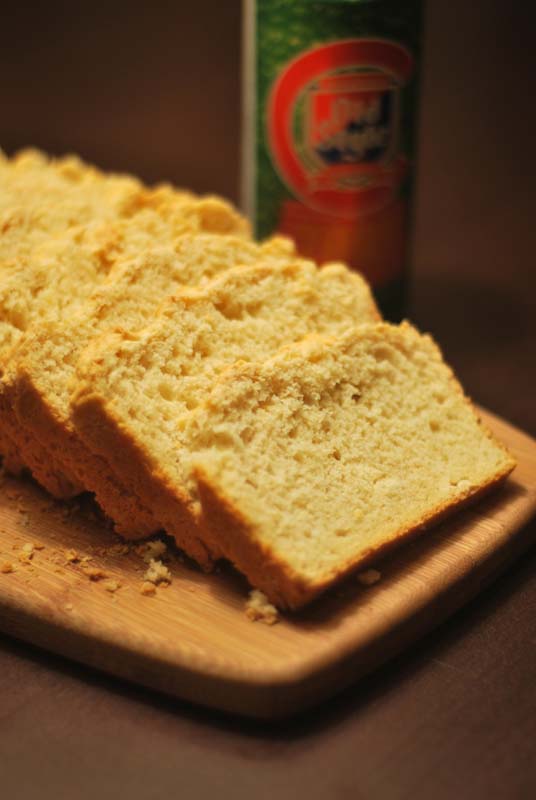Week Twenty-Five: Beer Bread Week!
After tinkering with flavorings and non-alcoholic liquids, the next beer bread variation I wanted to try was to add some sourdough starter. I used this recipe for the starter; but sadly, I finally had to lay that original one from back in March to rest, and start anew. So sad! Requiescat in pace, good and faithful starter.
Now, maybe this sounds a little batty to you, adding a yeasted starter into a quickbread. It even sounds a little batty to me. I wasn’t sure that it would do anything at all, really. It certainly wouldn’t make the bread fluffier, as the yeast wouldn’t have time to grow and give off those gases that makes yeast-leavened bread airy and full of holes; and the use of baking powder (which activates as soon as it’s moistened) prevented any rising time.
But one thing that sourdough starter does have is acid. Many acids, actually, for example, lactic and acetic acids. Those two acids in particular are important dough conditioners, and produce much better flavors and textures. In yeast bread, anyway. How would it act in a quickbread? Would the acids act on the dough immediately, or would they need time to provide any noticable change? So many questions! I had to give it a shot.
After many frantic hours of deliberation, pacing, and hair-tearing*, I decided to just mix everything all together at once, as opposed to mixing the starter and some of the flour together, giving it a rest, then mixing in the remaining ingredients. After all, I know for a fact that given time, those amazing acids in the starter will certainly improve the texture and flavor of any given bread. I was curious to know if they would act immediately.
Since I hate suspense, I’ll just tell you that the answer is no. But the experiment was not in vain; not only do I know that information now, but the starter did lend a tangy complexity to the finished bread. I was a little worried about the final texture, since I reduced the amount of beer used to compensate for the added moisture from the very liquid-y starter.
Based on my attempt earlier this week at swapping alcoholic beer for non-alcoholic root beer (not an abject failure, but not a success either), I thought it wise to keep as much beer in the mixture as possible. Armed with a formula** for adding in that particular starter, I settled on reducing the beer from 12 to 9 ounces, an amount I considered relatively safe. I added 3/4 cup of starter, which I felt would give an acceptable level of flavor, while not changing the basic beer bread too much.
In the end, the basic texture was pretty much exactly like the original beer bread, so a success there. As for the rest, well… I say you’re just as well off making original beer bread. The starter did lend a seductive note of sourdough to the smell, but there was only the faintest hint of it on the palate, and it had to build up on the back of your tongue as you ate a slice. It was certainly not on the front of the taste, and could even be missed if you weren’t looking out for it.
Not that this turned out badly; it was quite the opposite, actually. This was the variation most like the original, so far. It was delicious, soft, buttery, slightly sweet, pleasantly crumbly and hard to slice, everything that the original was. But that’s exactly why I’ll never make it again. It’s kind of like when they re-made the movie Psycho, shot for shot. Sure, it was pretty much as good as the first time around; but why bother with spending all the time and energy to fix something that ain’t broke? The original is just fine, thank you very much, and we don’t need any sourdough starters or Anne Heches or Vince Vaughans mucking things up. But thanks anyway.
(By the way, Vince Vaughan? Seriously, Mr. Casting Director?)
* – Author’s claimed distress may be vasty exaggerated.
** – For every cup of liquid and all of the yeast in the original recipe, substitute instead 1/2 cup of starter, 5 ounces of liquid, and 1/2 teaspoon instant yeast. In this application, I ignored the yeast.
And now, for something completely different:
Sourdough Beer Bread
Makes one 9 x 5 inch loaf
3 cups + 2 teaspoons all-purpose flour
3/4 cup sourdough starter, from this recipe
4 1/2 teaspoons baking powder
1/2 teaspoon salt
3 tablespoons sugar
3 tablespoons butter, melted and cooled slightly
9 ounces light beer, at room temperature
1. Preheat oven to 350º F. Lightly grease a 9 x 5 inch loaf pan, and sprinkle with 2 teaspoons all-purpose flour. Shake the flour around until the whole interior is coated, then knock out the excess.
2. In a medium bowl, whisk together the flours, baking powder, salt, and sugar. Add the butter and beer, and stir with a spoon or spatula until moist and just combined. Pour into prepared loaf pan.
3. Bake at 350º F for 40 to 45 minutes, or until golden brown on top. Remove from pan. Cool at least 10 minutes on a rack before slicing.
Notes:
1. After the bread is baked, loosen the edges with a knife if needed, and gently knock the edge of the pan on the counter to release the loaf.
2. This recipe can easily be made into muffins instead of a whole loaf. Grease and flour a muffin tin as directed, and fill each cup about halfway full. Bake for about 30 minutes, or until golden brown. Remove from tin and cool on a rack.


